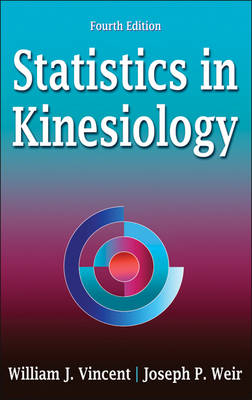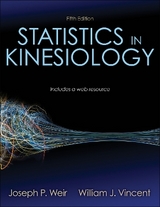
Statistics in Kinesiology
Human Kinetics (Verlag)
978-1-4504-0254-5 (ISBN)
- Titel erscheint in neuer Auflage
- Artikel merken
The only statistics text currently available specifically for kinesiology majors, Statistics in Kinesiology, Fourth Edition, provides an accessible introduction to statistics concepts and techniques and their applications to kinesiology-related fields. Students will learn to use statistical tools to analyze quantitative data and then apply that knowledge to common questions and problems they will encounter as they continue their studies.
The fourth edition has been fully updated with new content that reflects the changing face of the kinesiology discipline, including the following:
• A new chapter on clinical measures, including information on relative risk, odds ratios, and diagnostic testing, that will be especially pertinent to students in athletic training, physical therapy, and other fields dealing with clinical or rehabilitation populations
• More detailed coverage of analysis of covariance (ANCOVA), which is becoming the technique of choice for analyzing pretest–posttest control group design
• New material on statistical inference and correlations, including information on hypothesis testing, types of error, confidence intervals, and partial correlations
• Additional information on the quantification of reliability and its applications in kinesiology
Statistics in Kinesiology, Fourth Edition, begins with a thorough introduction to basic concepts such as measurement and research; organizing and displaying data; percentiles; mode, median, and mean; and measures of variability. The text then explores more advanced topics, including correlation and regression, t tests, analysis of variance (ANOVA), and analysis of nonparametric data. While the book offers an overview of the most important statistical concepts and techniques, the emphasis remains on those commonly used concepts in kinesiology disciplines, such as repeated measures ANOVA and the interpretation of interactions in factorial ANOVAs.
The fourth edition features extensive problem sets that will help students begin to calculate and interpret data. To enhance learning, students are encouraged to practice the calculations manually, but knowledge of advanced mathematics is not required. The examples given involve only basic algebra skills. Information on computer-based application is also provided throughout the book. In becoming familiar with the mathematical formulas used by software programs, students will learn to critically evaluate computer results and interpret data with greater confidence and ease.
In updating this text, the authors have been careful to retain the features that have made past editions such a success. Examples drawn from exercise physiology, biomechanics, physical education, and physical therapy help students relate to how the techniques are used and how those techniques allow them to answer questions in their chosen fields. The problem sets are designed to help students interact more fully with the content, thereby aiding in their comprehension of concepts and techniques. Answers for each of the problem sets are located in the back of the text and give students the opportunity to check their work as they progress. Chapter summaries and key words lists identify content that students should carefully review.
With Statistics in Kinesiology, Fourth Edition, students will gain a solid understanding of the statistical techniques used in physical activity fields. The book’s practical approach, based on the authors’ more than 50 years of combined experience in teaching statistics, will make it easy for students to learn these important, but often intimidating, concepts.
William J. Vincent, EdD, is currently an adjunct professor and is the former director of the general education wellness program in the department of exercise sciences at Brigham Young University in Provo, Utah. He is professor emeritus and former chair of the department of kinesiology at California State University at Northridge. He was employed at CSUN for 39 years and taught statistics and measurement theory for 35 of those years. In 1995 he received the University Distinguished Teaching Award. Dr. Vincent has been a member of the American Alliance for Health, Physical Education, Recreation and Dance since 1964. In 2007, he received the AAHPERD National Honor Award for distinguished service to the profession. He has served as the president of the Southwest District of AAHPERD and was a member of the AAHPERD Board of Governors from 1993 to 1995. In 1988 he was named the Southwest District Scholar and delivered the keynote address titled "From Means to Manova" at the 1989 convention. Dr. Vincent is the author or coauthor of 4 books and more than 70 professional articles. Fifty-one of those articles appeared in refereed journals, including Research Quarterly for Exercise and Sport, the International Journal of Sports Medicine, and the Journal of Athletic Training. He has a bachelor’s degree in physical education (pedagogy), a master’s degree in physical education (exercise physiology), and a doctorate in educational psychology (perception and learning), all from the University of California at Los Angeles. Dr. Vincent and his wife, Diana, live in Lindon, Utah, and have 6 children and 20 grandchildren. In his free time, Dr. Vincent enjoys camping, snow skiing and water skiing, conducting genealogical research, and reading. Joseph P. Weir, PhD, is a professor in the doctor of physical therapy program at Des Moines University in Iowa. He earned his doctorate in exercise physiology from the University of Nebraska at Lincoln. Dr. Weir is a fellow of both the American College of Sports Medicine (ACSM) and the National Strength and Conditioning Association (NSCA). He was given the NSCA President’s Award in 2007 and its William J. Kraemer Outstanding Sport Scientist Award in 2006. He served as president of the National Strength and Conditioning Association Foundation from 2006 to 2009, and he was cochair of the ACSM’s Biostatistics Interest Group from 2001 to 2003. Dr. Weir is the associate editor of the Journal of Strength and Conditioning Research, and he is a member of the editorial board of Medicine and Science in Sports and Exercise. He is the author of numerous research articles, which have appeared in journals including European Journal of Applied Physiology, Physiological Measurement, American Journal of Physiology, and the Journal of Orthopaedic and Sports Physical Therapy. He is coauthor of Physical Fitness Laboratories on a Budget, and he has contributed chapters to seven texts, including NSCA’s Essentials of Personal Training. Dr. Weir is originally from Glennallen, Alaska. He and his wife, Loree, live near Des Moines, Iowa, and have three children. Dr. Weir is an avid motorcyclist and fan of University of Nebraska football.
Chapter 1. Measurement, Statistics, and Research
What Is Measurement?
Process of Measurement
Variables and Constants
Research Design and Statistical Analysis
Statistical Inference
Summary
Problems to Solve
Key Words
Chapter 2. Organizing and Displaying Data
Organizing Data
Displaying Data
Summary
Problems to Solve
Key Words
Chapter 3. Percentiles
Common Percentile Divisions
Calculations Using Percentiles
Summary
Problems to Solve
Key Words
Chapter 4. Measures of Central Tendency
Mode
Median
Mean
Relationships Among the Mode, Median, and Mean
Summary
Problems to Solve
Key Words
Chapter 5. Measures of Variability
Range
Interquartile Range
Variance
Standard Deviation
Calculating Standard Deviation for a Sample
Coefficient of Variation
Standard Deviation and Normal Distribution
Summary
Problems to Solve
Key Words
Chapter 6. The Normal Curve
Z Scores
Standard Scores
Probability and Odds
Calculating Skewness and Kurtosis
Summary
Problems to Solve
Key Words
Chapter 7. Fundamentals of Statistical Inference
Predicting Population Parameters Using Statistical Inference
Estimating Sampling Error
Levels of Confidence, Confidence Intervals, and Probability of Error
An Example Using Statistical Inference
Statistical Hypothesis Testing
Type I and Type II Error
Degrees of Freedom
Living With Uncertainty
Two- and One-Tailed Tests
Applying Confidence Intervals
Summary
Problems to Solve
Key Words
Chapter 8. Correlation and Bivariate Regression
Correlation
Calculating the Correlation Coefficient
Bivariate Regression
Homoscedasticity
Summary
Problems to Solve
Key Words
Chapter 9. Multiple Correlation and Multiple Regression
Multiple Correlation
Partial Correlation
Multiple Regression
Problems to Solve
Key Terms
Chapter 10. The t Test: Comparing Means From Two Sets of Data
The t Tests
Types of t Tests
Magnitude of the Difference (Size of Effect)
Determining Power and Sample Size
The t Test for Proportions
Summary
Problems to Solve
Key Words
Chapter 11. Simple Analysis of Variance: Comparing Means Among Three or More Sets of Data
Assumptions in ANOVA
Sources of Variance
Calculating F
Determining the Significance of F
Post Hoc Tests
Magnitude of the Treatment (Size of Effect)
Summary
Problems to Solve
Key Words
Chapter 12. Analysis of Variance With Repeated Measures
Assumptions in Repeated Measures ANOVA
Calculating Repeated Measures ANOVA
Correcting for Violations of the Assumption of Sphericity
Post Hoc Tests
Interpreting the Results
Summary
Problems to Solve
Key Words
Chapter 13. Quantifying Reliability
Intraclass Correlation Coefficient
Standard Error of Measurement
Summary
Problems to Solve
Key Words
Chapter 14. Factorial Analysis of Variance
A Between–Between Example
A Between–Within Example
A Within–Within Example
Summary
Problems to Solve
Key Words
Chapter 15. Analysis of Covariance
Relationship Between ANOVA and Regression
ANCOVA and Statistical Power
Assumptions in ANCOVA
The Pretest–Posttest Control Group Design
Pairwise Comparisons
Summary
Problems to Solve
Key Words
Chapter 16. Analysis of Nonparametric Data
Chi-Square (Single Classification)
Chi-Square (Two or More Classifications)
Rank Order Correlation
Mann-Whitney U Test
Kruskal-Wallis ANOVA for Ranked Data
Friedman’s Two-Way ANOVA by Ranks
Summary
Problems to Solve
Key Words
Chapter 17. Clinical Measures of Association
Relative Risk
Odds Ratio
Diagnostic Testing
Summary
Problems to Solve
Key Words
Chapter 18. Advanced Statistical Procedures
Meta-Analysis
Multiple Analysis of Variance
Factor Analysis
Discriminant Analysis
Summary
Problems to Solve
Key Words
| Zusatzinfo | 6 |
|---|---|
| Verlagsort | Champaign, IL |
| Sprache | englisch |
| Maße | 152 x 229 mm |
| Gewicht | 771 g |
| Themenwelt | Sachbuch/Ratgeber ► Gesundheit / Leben / Psychologie ► Alternative Heilverfahren |
| Mathematik / Informatik ► Mathematik ► Statistik | |
| Studium ► 1. Studienabschnitt (Vorklinik) ► Physiologie | |
| Sozialwissenschaften ► Pädagogik | |
| ISBN-10 | 1-4504-0254-2 / 1450402542 |
| ISBN-13 | 978-1-4504-0254-5 / 9781450402545 |
| Zustand | Neuware |
| Informationen gemäß Produktsicherheitsverordnung (GPSR) | |
| Haben Sie eine Frage zum Produkt? |
aus dem Bereich



